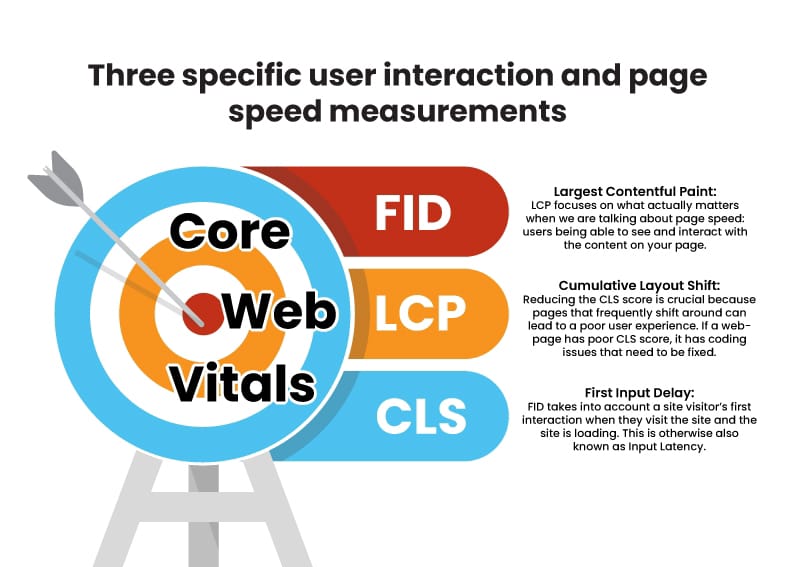
Core Web Vitals are Google’s set of user-experience metrics that assess website loading, visual stability, and responsiveness, now directly impacting search ranking and business outcomes. In 2025, Google prioritises three fundamental metrics:
- Largest Contentful Paint (LCP): Time for the primary content element to render; target under 2.5 s.
- Cumulative Layout Shift (CLS): Measures unexpected visual shifts; should score <0.1.
- Interaction to Next Paint (INP): Replaced FID in 2024, capturing page responsiveness; should be <200 ms.
These metrics reflect real-world usage, as reported in the Chrome User Experience Report (CrUX), rather than just lab simulations. Good scores enhance SEO, reduce bounce rates, and boost conversions.
📈 Why CWV Is a Strategic Priority for Businesses
- Competitive Search Advantage
Google’s page‑experience signals now shape search rankings on both mobile (since May 2021) and desktop (since early 2022). Websites that excel in CWV are more visible and trusted, pushing slower competitors further down results.
- Enhanced User Engagement & Loyalty
Faster, smoother pages lead to happier visitors: Deloitte and Google data show shaving just 0.1s from load time can significantly enhance the buyer journey.
- Direct Revenue Uplift
Case in point: T-Mobile improved visit-to-order rates by 60% and cut in-site issues by 20% after focusing on user experience and CWV.
🛠 Practical Steps to Optimize Core Web Vitals in 2025
A systematic approach ensures effective results:
Audit & Monitor
- Use Google Search Console (Core Web Vitals report) for an overview by URL group.
- Utilize PageSpeed Insights and Lighthouse for in-depth lab & field analysis.
- Implement RUM tools like WebPageTest, Chrome DevTools, DebugBear, New Relic AI for real-world performance monitoring.
Tackle LCP
- Prioritize above‑the‑fold content: Preload hero images/fonts; defer non-essential CSS/JS.
- Optimize server response: Use fast CDNs (HTTP/2), leverage caching and compression.
- Compress and modernize media: Resize images, use WebP/AVIF, lazy-load off-screen media.
Control CLS
- Reserve space for dynamic elements (images, ads, embeds) via CSS, avoiding sudden layout shifts.
- Define explicit widths/heights, use aspect-ratio, and avoid injecting new content above existing content.
Improve INP
- Break big JavaScript tasks using code-splitting, web workers, async/defer loading.
- Trim your DOM: fewer nodes = less work for browsers.
- Minimize third-party scripts and ad burden—balance revenue with performance.
Embrace AI‑powered optimizations
For 2025, cutting-edge AI tools like Uxify’s Navigation AI and New Relic AI provide real-time asset prioritization, predictive preloading, and auto-diagnostics, delivering CWV lifts with lower effort.
AI Benefits:
- Fast, scalable analysis of data
- Proactive node and asset management
- Predictive insights and auto-fixes
📊 Post‑Optimization: Measure, Iterate, Repeat
Improvements should align with real gains:
- Track CWV via Search Console, PageSpeed Insights, CrUX.
- Re-test after each website change using RUM tools, Chrome extension, or GTMetrix .
- Maintain a performance dashboard to monitor regressions over time.
🚀 The Future of CWV is Staying Ahead
CWVs are evolving. Google now updates metrics annually, replacing FID with INP in 2024, refining LCP handling, and running experiments with image loading priority (Chrome 116). Expect new smoothness metrics or animation-focused measures next.
Stay adaptive: subscribe to Google’s CWV changelog and performance news to anticipate updates.
🔧 2025 CWV Roadmap for Business Leaders
- Set benchmarks: Baseline current CWV scores.
- Prioritize investments: Focus on high-traffic, high-conversion pages.
- Invest in tools: Opt for RUM solutions and AI optimization platforms.
- Cross-functional alignment: Engage developers, UX teams, and marketers.
- Iterate continuously: Test, deploy, measure, repeat.
Conclusion
In 2025, Core Web Vitals are non-negotiable. They shape SEO success and digital user engagement. Start with thorough audits, prioritise improvements to LCP, CLS, and INP, leverage AI innovation, and commit to an agile monitoring cycle. Trust that the payoff includes stronger search visibility, smoother user journeys, and a measurable lift in engagement and conversion.
With this guide, you’re fully equipped to champion web performance within your organisation and lead the journey toward faster, more stable, and more responsive websites worldwide.
Let’s make speed your strategic asset in 2025. Reach out to us at bozng.com